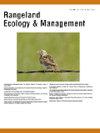烧地放牧:牛-小牛生产者热草地管理的经济分析
IF 2.4
3区 环境科学与生态学
Q2 ECOLOGY
引用次数: 0
摘要
牧场管理决策要求养牛者选择提高牧场可持续性的做法,以维持牛的生产,同时保持盈利。东部红杉(Juniperus virginia)由于灭火而入侵大平原,限制了牛的放牧用地。木本植物的入侵,再加上干旱影响和高投入成本,对牛生产者来说变得昂贵,他们被迫补充或减少库存,或两者兼而有之。斑块燃烧放牧是一种基于对火和放牧(pyric草食)相互作用的理解的做法,它将牧场分成几个部分,每年轮流燃烧一个部分。它通过提供高质量的牧草、缓解干旱影响和控制WPE来提高牧场生产力。尽管有这些好处,养牛者采用的烧地放牧是有限的。我们的目标是通过估算成本和长期经济效益,并将其与每3年烧毁整个牧场的传统方法进行比较,提高人们对斑块燃烧放牧效益的认识。在构建经济分析时,我们的目标是计算利用成本,量化高质量牧草和缓解干旱影响的效益。结果表明,与每3年烧一次整个牧场相比,每年每公顷烧一次牧场的成本约为5.94美元。在最近被烧过的地区,奶牛可以持续获得高质量的饲料,因此每年每头奶牛的冬季补充成本可节省20美元。此外,在干旱前利用斑块燃烧放牧,干旱期间不燃烧,干旱后恢复,与传统管理做法相比,6年后补充和燃烧成本降低4.5%,每头牛的未来节约价值增加100.21美元。对斑块燃烧放牧的经济分析提供了有益的经济信息,以帮助小牛生产者在牧场管理决策过程中。本文章由计算机程序翻译,如有差异,请以英文原文为准。
Patch-Burn Grazing: An Economic Analysis of Pyric Herbivory Rangeland Management by Cow–Calf Producers
Rangeland management decisions require cattle producers to select practices that improve the sustainability of rangelands to maintain cattle production while remaining profitable. The invasion of Eastern red cedar (Juniperus virginiana) across the Great Plains due to fire suppression is limiting grazeable land for cattle. Woody plant encroachment (WPE), combined with drought impacts and high input costs, becomes expensive for cattle producers who are forced to supplement, destock, or both. Patch-burn grazing is a practice based on the understanding of the interaction of fire and grazing (pyric herbivory) that divides a pasture into sections, burning one section rotationally each year. It offers improved rangeland productivity by providing high-quality forages, mitigation for drought impacts, and control of WPE. Despite these benefits, the adoption of patch-burn grazing by cattle producers is limited. Our goal involved increasing awareness of the benefits of patch-burn grazing by estimating the costs and long-term economic benefits and comparing them to those of one of the more traditional approaches of burning an entire pasture every 3 yr. In building an economic analysis, our objectives were to calculate utilization costs and quantify the benefits of high-quality forages and drought impact mitigation.
Results indicated that patch-burn grazing will cost approximately $5.94 more per hectare per year than burning the entire pasture every 3 yr. The benefit of cows having continual access to high-quality forages in recently burned areas results in savings of $20 per head per year in winter supplementation costs. Additionally, utilizing patch-burn grazing before a drought, not burning during a drought, and resuming after the drought reduce supplementation and burn costs by 4.5% and increase future value of savings by $100.21 per cow compared with those caused by traditional management practices after 6 yr. An economic analysis of patch-burn grazing provides beneficial economic information to aid cow–calf producers in the decision-making process of rangeland management.
求助全文
通过发布文献求助,成功后即可免费获取论文全文。
去求助
来源期刊

Rangeland Ecology & Management
农林科学-环境科学
CiteScore
4.60
自引率
13.00%
发文量
87
审稿时长
12-24 weeks
期刊介绍:
Rangeland Ecology & Management publishes all topics-including ecology, management, socioeconomic and policy-pertaining to global rangelands. The journal''s mission is to inform academics, ecosystem managers and policy makers of science-based information to promote sound rangeland stewardship. Author submissions are published in five manuscript categories: original research papers, high-profile forum topics, concept syntheses, as well as research and technical notes.
Rangelands represent approximately 50% of the Earth''s land area and provision multiple ecosystem services for large human populations. This expansive and diverse land area functions as coupled human-ecological systems. Knowledge of both social and biophysical system components and their interactions represent the foundation for informed rangeland stewardship. Rangeland Ecology & Management uniquely integrates information from multiple system components to address current and pending challenges confronting global rangelands.
 求助内容:
求助内容: 应助结果提醒方式:
应助结果提醒方式:


